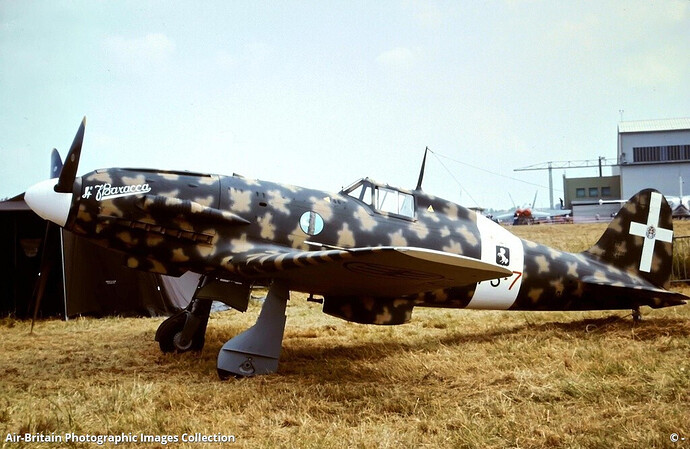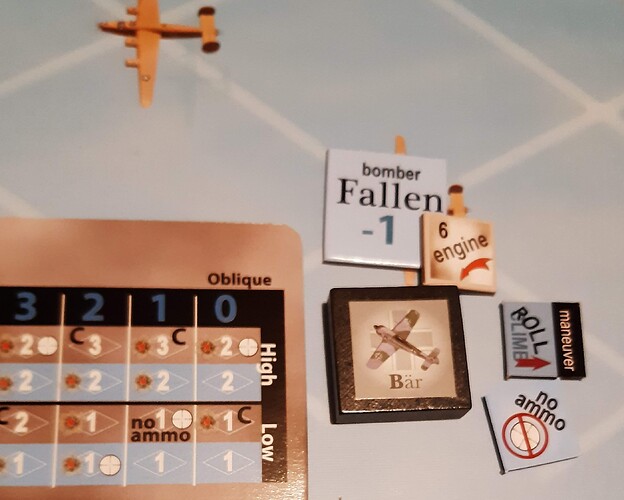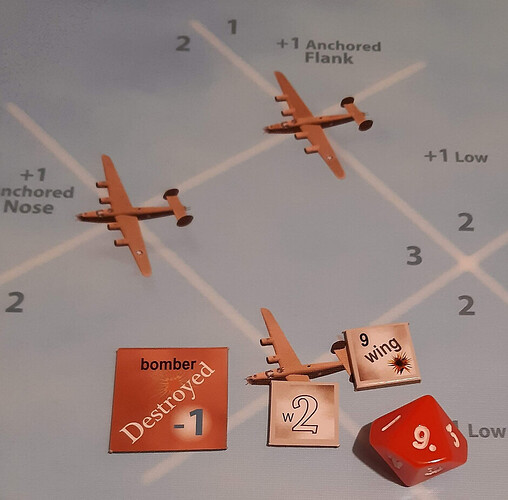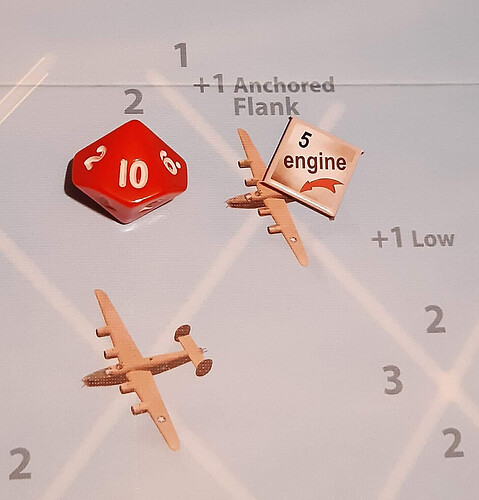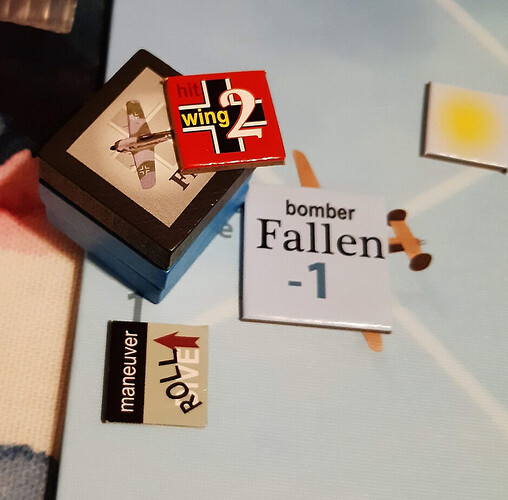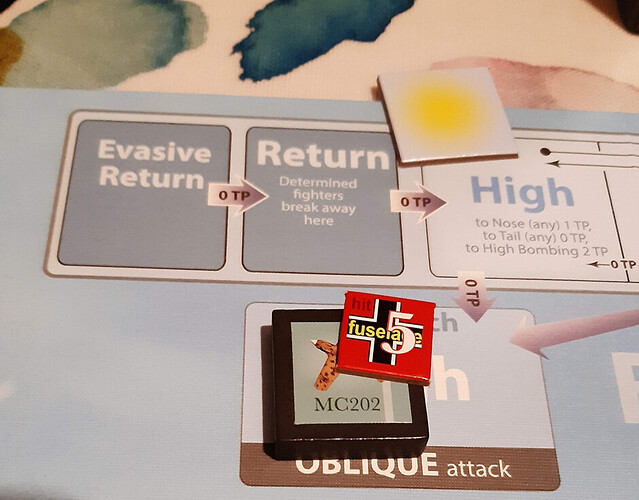Early 1943 – Mission 1.
My starting roster of 18 pilots (named alphabetically from Ahrens to Zick for ease of distinction) includes 4 aces (which have a skill each that helps them in play). My goal for the season is to retain a minimum of 14 pilots on my roster, whilst losing no more than 8. Victory requires an accumulated total of 20 VPs over the 6 missions, whilst scoring less than 10 VPs is a loss. VPs are awarded for causing bombers to fall out of formation, or to be destroyed, with value varying if the formation is inbound to their target location, or near/outbound from the target. This season is 6 missions long.
Play starts with setting up the mission situation. Dice are rolled to generate what type of formation the bombers are flying (which dictates the board in play), the amount of Operation Points (OP) available, whether the formation are inbound, near the target or outbound, and the flight limit (i.e. how turns before you have to break off and return to base).
For my first mission the bombers are in a proto-formation, as per the image in the first post, and they are near-target. I have only 4 OPs, and a Flight Limit of 5 turns. Clearly this is a scramble to intercept a force at the edge of my operational area. I select three pilots from my Staffel, Ahrens, Bar and Ehlers and get their Fw-190s airborne. Ahrens and Bar are two of my aces, and their extra talents might add an edge during critical moments. I also organise a pair of Italian Macchi MC202s to join my pilots, figuring five planes should hopefully compensate for the short Flight Limit. Once my force has been decided, I roll to see what sort of escorts are accompanying the bombers, and find a light screen of P-40 Kittyhawks. They are due to peel away on Turn 3, but have taken up position trailing and above the bomber formation. This is unfortunate, as it gives them the best field of view to detect oncoming threats and makes them more responsive to the presence of my fighters.
I ponder my options. Fighters enter the map at low altitude from any of four sectors – the nose, tail or on either flank of the formation. The sun is high on the flank of the formation in the 2-4 O’clock position, which gives some defensive advantages to any fighter approaching from that angle. It takes a few turns for fighters to gain altitude or to move around to alternate approach sectors. Tactical Point (TP) can be used to help shift planes around faster. These are rolled for during set-up, and I managed to get only a single TP. That combined with the 5 turn Flight Limit effectively means I can either get one pass with time spent to co-ordinate approaches and to get better height advantages, or I can rush in early and maybe come around again for a second pass. I decide to go for the former- Ahrens starts low on the flank at the 2-4 O’clock, intending to climb him high to make use of the sun. Ehlers and Bar are on the other flank at formation’s 8-10 O’clock. The two MC202s enter tailing the formation.
Before any plan can come together, the escorts quickly interfere, with the Kittyhawks swooping down onto the MC202s from their tailing-above station. They force one MC202 to break-away, but manage to shoot the second one down, with the pilot failing to bail out. Not an auspicious start – one turn in, and I’ve lost 40% of my fighters! One escort has exited after the MC202 who was forced away, the rest peel back to trailing below the formation.
The next couple of turns are comparatively uneventful. My Fw-109s gain altitude, moving to level with the formation, and then higher than the bombers. The escorts switch station, heading back to trailing above, but thankfully have to exit before they have the chance to take any further actions.
Turn 4 sees my three Fw-109 move into the approach boxes, ready to make a pass on the bomber formation. As the formation is near the target, they have been hit with flak every turn, causing some damage on a pair of bombers at the outer edge towards the 8-10 O’clock. The accumulation of damage has not been enough to knock them out completely, but it has caused the formation to first lose cohesion, and then fall apart entirely. These leaves these damaged bombers potentially vulnerable, and certainly a less dangerous proposition to attack.
(Mechanically each turn you roll a dice against the number of markers within a formation element; if you roll low, you get to add ‘loosen’ and then ‘kaput’ formation token, which modifies the lethality of the defensive fire from the bombers).
By chance, turn 4 also heralded a cessation in the flak barrage, so there is no danger to my approaching fighters from friendly fire. A lucky roll, but it seems like carefully planned co-ordination. I move my fighters onto the map around the damaged bombers, Ehlers and Ahrens attacking one B-24 from either side, both swooping down from high, whilst Bar makes a lone run on the second bomber. I messed up a bit here, losing a chance to get some attacking advantage by having fighters target a single bomber from different altitudes and approaches – everyone is coming in from high. Something to remember for the future.
Fighters select a manoeuvre to show where the are heading after they pass, being either a dive or a climb that passes straight ahead, or with a roll veer either left or right. They also choose a mode, whether they are determined or evasive (the former typically causing more damage, the latter avoiding return fire). Since this one pass is all that can be achieved this mission, everyone goes in determined. Attacks are resolved by drawing a card and reading a table that compares the lethality of bomber defensive fire, the height of the fighter, and their mode. Ehlers fails to cause any damage at all, and is forced to breakaway due to an unlucky draw, whilst Ahrens hits the bomber, but fails to cause any catastrophic damage. Bar likewise punches some holes along the bomber’s fuselage, but hits nothing vital, and there is not enough accumulated damage to destroy the bomber either. So it appears to have been a very ineffective mission as the fighters pass over their targets.
However, once an attack runs have been resolved, Continuing Fire cards are drawn. These represent some random events and the defensive fire tracking after the fighters as they break away after their approach. I get some lucky draws – Bar pulls a card with a Debris event; there something in the air that collides with either the fighter or the nearest bomber depending on a dice roll. Fortunately, it is the bomber that is battered by debris, and this causes a catastrophic hit, destroying the bomber. Bar sneakily claims the kill. Ahrens gets a ‘Strafing’ event, which allows an ace to potentially add more damage to a nearby bomber. He ends up holing the second bomber’s wing, and it falls out of formation.
The three fighters regroup. Bar has some hits as a result of his card draws, but they are found to be trivial damage. There’s not enough flight time left for the fighters to swing around for another approach, so the mission ends with 1 bomber destroyed, and 1 bomber fallen, to the cost of a lost MC202.
As the bombers were near target, I score 1 VP for the fallen bomber and 1 VP for the destroyed bomber. 2 VPs in total, which doesn’t seem like much. Ahrens and Bar gain some experience for their kills, as does the Staffel as a whole. Unfortunately the lost MC202 means I lose some Staffel experience, and 1 OP for the next mission. My roster of Fw-190 pilots is still full though, which is definitely a good thing. I get the sense I may have to balance up risk and reward more frequently as the season progresses - keeping pilots alive is all well and good, but not if I fail to take down more bombers.
(Completely forgot to take any pictures during this mission – there will be some next time around! Here’s a MC202 to look at alongside the wall of text.)

